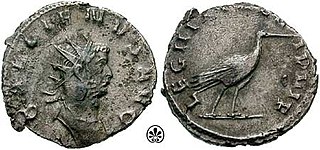
Legio IV Macedonica, was a legion of the Imperial Roman army founded in 48 BC by Gaius Julius Caesar with Italian legionaries. The legion was disbanded in AD 70 by Emperor Vespasian. The legion symbols were a bull and a capricorn.

Legio VIII Augusta was one of the oldest legions of the Imperial Roman army.

Legio II Adiutrix, was a legion of the Imperial Roman army founded in AD 70 by the emperor Vespasian, originally composed of Roman navy marines of the classis Ravennatis. There are still records of II Adiutrix in the Rhine border in the beginning of the 4th century. The legion's symbols were a Capricorn and Pegasus.

Legio X Gemina, was a legion of the Imperial Roman army. It was one of the four legions used by Julius Caesar in 58 BC, for his invasion of Gaul. There are still records of the X Gemina in Vienna in the beginning of the 5th century. The legion symbol was a bull. Early on in its history, the legion was called X Equestris (mounted), because Caesar once used the legionaries as cavalry.

Legio XIII Gemina, in English the 13th Twin Legion was a legion of the Imperial Roman army. It was one of Julius Caesar's key units in Gaul and in the civil war, and was the legion with which he famously crossed the Rubicon on January 10, 49 BC. The legion appears to have still been in existence in the 5th century AD. Its symbol was the lion.

Legio XXII Primigenia was a legion of the Imperial Roman army dedicated to the goddess Fortuna Primigenia. Founded in AD 39 by the emperor Caligula for use in his campaigns in Germania, the XXII Primigenia spent much of their time in Mogontiacum up to the end of the 3rd century. The legion's symbols were a Capricorn and the demigod Hercules.

Legio III Italica was a legion of the Imperial Roman army founded in AD 165 by the emperor Marcus Aurelius, for his campaign against the Marcomanni tribe. The cognomen Italica suggests that the legion's original recruits were mainly drawn from Italy. The legion was still active in Raetia and other provinces in the early 5th century.

Legio VI Victrix was a legion of the Imperial Roman army founded in 41 BC by the general Octavian. It was the twin legion of VI Ferrata and perhaps held veterans of that legion, and some soldiers kept to the traditions of the Caesarian legion.

The Legion of Mary is an international association of members of the Roman Catholic Church who serve it on a voluntary basis. It was founded in Dublin, as a Roman Catholic Marian Movement by the layman and civil servant Frank Duff.

Legio V Macedonica was a Roman legion. It was probably originally levied in 43 BC by consul Gaius Vibius Pansa Caetronianus and Gaius Iulius Caesar Octavianus. It was based in the Balkan provinces of Macedonia, Moesia and Dacia. In the Notitia Dignitatum records from beginning of the fifth century, the legion was still stationed in Dacia, with detachments stationed in the east and Egypt.

Legio V Iovia was a Roman legion levied by Diocletian in the end of the 3rd century, and was still in service at the beginning of the 5th century. The cognomen of the legion refers to Jupiter, to whom Diocletian was devoted and identified.

Legio VI Herculia was a Roman legion levied by Diocletian in the end of the 3rd century, and was still in service at the beginning of the 5th century. The cognomen of the legion refers to Hercules, to whom Diocletian's colleague, Maximian, was devoted and identified.

Legio XV Apollinaris was a legion of the Imperial Roman army. It was recruited by Octavian in 41/40 BC. The emblem of this legion was probably a picture of Apollo, or of one of his holy animals.

Vindobona was a Roman military camp on the site of the modern city of Vienna in Austria. The settlement area took on a new name in the 13th century, being changed to Berghof, or now simply known as Alter Berghof.
Legio III Isaura was a pseudocomitatensis Roman legion, levied no later than under Diocletian, and possibly already present under Probus. As their name suggests, III Isaura and its twin legion II Isaura were guarding the Isauria territory at the time of the Notitia Dignitatum, to defend it from the incursions of the mountain peoples. It is possible that in the beginning they were supported by I Isaura Sagittaria.

Legio I Isaura Sagitaria was a pseudocomitatensis Roman legion, the legion was probably created by emperor Probus. It is possible that in the beginning it was used to defend the Isauria region, together with the II and III Isaura. The legion campaigned against the tribes of Cilicia. As its name suggests, its legionaries could be used also as archers, an uncommon feature for Roman legions. According to Notitia Dignitatum, in the beginning of the 5th century the I Isaura was under the command of the Magister Militum per Orientem.

Francis Michael Duff,L.O.M. known as Frank Duff is known especially for bringing attention to the role of the laity during the Second Vatican Council of the Roman Catholic Church as well as for founding the Legion of Mary in his native city of Dublin, Ireland.
Publius Aelianus Aelianus was a senior officer in the Imperial Roman army in the mid-Third Century AD who rose from relatively lowly origins to become the prefect of a legion under the Emperor Gallienus He was one of the earliest beneficiaries of Gallienus's policy that effectively excluded senators from army commands in favour of career-soldiers of equestrian rank. His later life is obscure.
Traianus Mucianus was a Roman soldier of Thracian origins of the second half of the Third Century AD who rose from the lowest ranks of the army to senior commands. He was almost certainly a remarkable soldier. However, the successive promotions he secured in the latter part of his career are thought to owe much also to the favour shown him by men highly placed in the Imperial entourage whose patronage secured him advantageous postings in the Imperial comitatus, the mobile field force under the direct command of the Emperor, that was undergoing massive expansion at this time.










